I’ve never been that wild about Top Chef — it’s fun now and then — but this site is a heart-warming return to the Web of old.
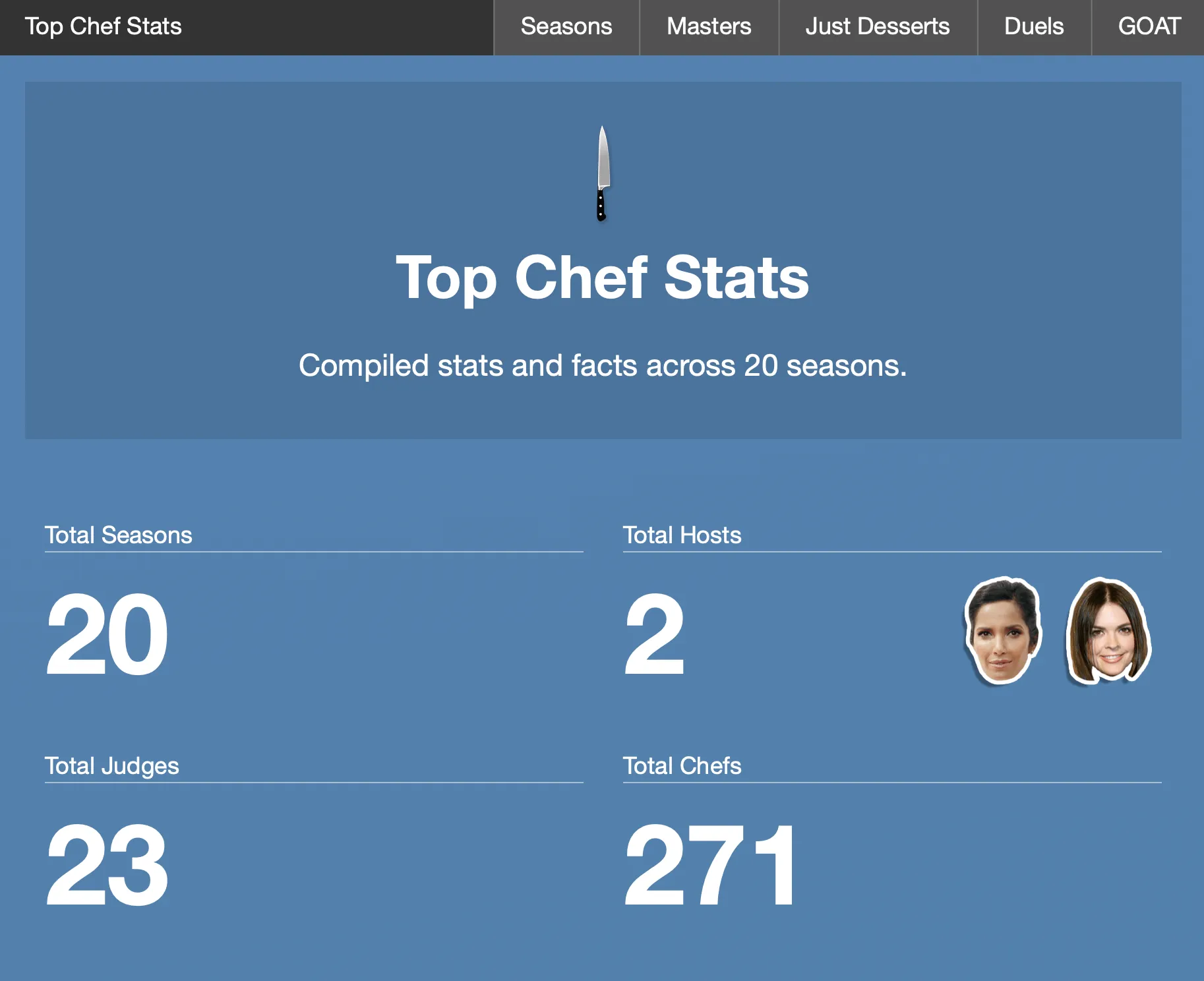
I’ve never been that wild about Top Chef — it’s fun now and then — but this site is a heart-warming return to the Web of old.

By Ste Grainer, at A List Apart.
Today, with a few commands and a couple of lines of code, we can prototype almost any idea. All the tools that we now have available make it easier than ever to start something new. But the upfront cost that these frameworks may save in initial delivery eventually comes due as upgrading and maintaining them becomes a part of our technical debt.
Chris Aldrich: everything about zettelkasten, commonplace books, and more.
Below I’ve aggregated a list of some of the longer articles and material I’ve written about these topics. The completist can find and search my site for even more specific material with these tags: zettelkasten, commonplace books, and note taking. I’ve also contributed a fair amount to the Wikipedia pages for zettelkasten and commonplace books.
I was revisiting “Hypertext In The Age Of Trump”, in Intertwingled. It holds up.
The future of serious writing lies on the screen. But there may be no future of serious writing, because it seems increasingly probable that there will be no future.
We built tools that might permit legislators to understand the laws on which they voted. The legislators did not want to understand. They wanted to win the next election, or to receive a lucrative sinecure if they lost. We built textbooks that could adapt themselves to readers of disparate backgrounds, inclinations, cultures. The readers did not want such textbooks; they wanted credentials.
We built social media platforms to bring people together. “People” did not particularly want to be brought together. Nazis wanted to meet other Nazis, though, so we helped with that. Con artists wanted to meet more victims, and we helped them, too.
The PR agencies hired by thieves, extortionists and murderers wanted to improve their clients’ image. We gave them Wikipedia and didn’t ask for a receipt.
We built research platforms, scholars’ workbenches, digital libraries and crisis management systems so that, when we needed an answer, we’d be ready. When the day came and the planet was on fire, people decided they’d rather watch a reality television personality own the libs.
Rick Perlstein, author of Before The Storm and Nixonland.
Some of the Kissinger obits were scathing, others obsequious. But with only one partial exception, none scooped what I wanted to say, and the most important thing to know about the man: that his every major geostrategic initiative was a failure on his own terms, each failure seeding a separate epochal ordeal for American foreign policy, lasting us into the present.
I’ve misplaced a reference. Do you know it?
Does this ring a bell?
(March 7: Found it! Gaver, Bill and Martin , Heather (2000), ‘Alternatives: Exploring Information Appliances through Conceptual Design Proposals’, CHI 2000, 209-16. Passing this post to Chat-GPT turned out to be the key step, not because ChatGPT found the paper — it invented a plausible paper that it claimed was to be found in CHI ’96, but did not exist — but because one of the authors ChatGPT suggested seemed plausible.)
Beck Tench uses Tinderbox to prepare for a webinar interview.
I was in a webinar interview about participatory design and I knew the questions beforehand. I normally write out my talking points before giving a talk, but I find it stressful to follow them. In the screenshots below, you’ll see how I mapped those talking points to reference as I answered the questions. I had the webinar on one screen, Tinderbox on another, and I panned left as the conversation evolved.
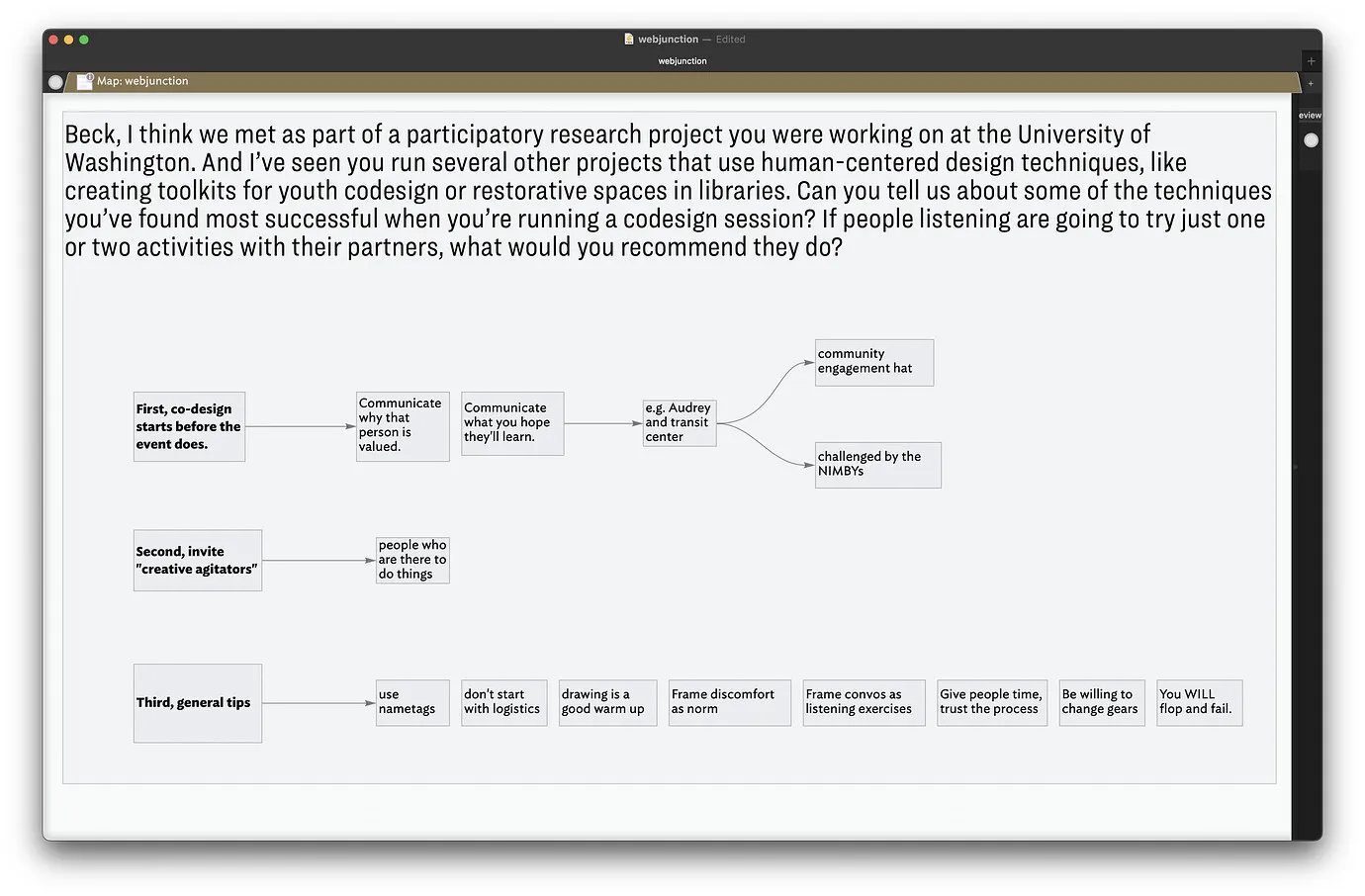
From horror show to triumph! This is the moment when pianist Maria Joao Pires realises - as the orchestra starts to play - that she has learned the wrong piece for a concert. With no sheet music to fall back on, she has to keep calm and carry on. She is AMAZING. As is conductor… pic.twitter.com/BR9TJqhLMs
— Joanna Gosling (@joannagtweets) February 25, 2024
Maria Joao Pires prepared the wrong concerto. From 1997, but evergreen.
Embark. (Paul Sonnentag, Alexander Obenauer, and Geoffrey Litt. Nov 2023. Embark: Dynamic Documents as Personal Software. LIVE 2023: The Ninth Workshop on Live Programming. Cascais, PT. )
We report on our experiences using Embark to plan a variety of real trips, ranging from weekend getaways to international business trips to sprawling RV journeys, all within a single medium. More broadly, our work proposes an approach to unbundling apps into data, computations, and views which can be flexibly composed by users to meet their unique goals.
I’m remodeling the templates. Things might break for a bit. Let me know if there's something ghastly.
You can now use NoteCards — the classic mid-1980s hypertext system from Xerox PARC — in your web browser. Incredible!
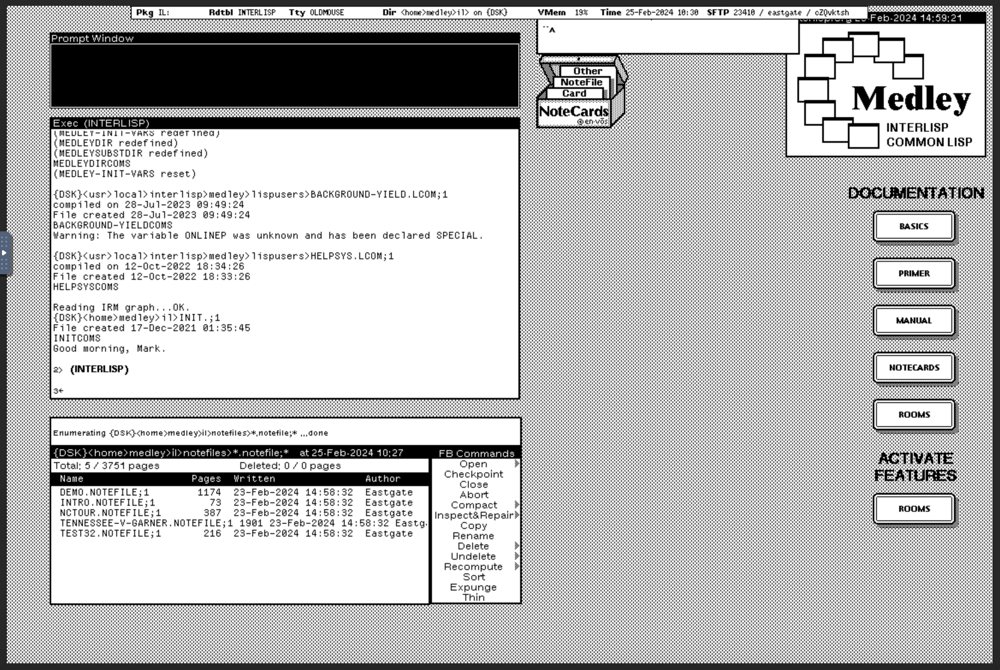
Reflections on Two Years of Russia's Invasion: A sobering reality check and a call to action. Tatyana Deryugina, University of Illinois.
Europe is now in the greatest danger it’s been since World War II, largely due to its leaders’ lack of resolve and misunderstanding of Putin and Russia. There’s a real chance that, without governments taking much more decisive and swift action than they have so far, we will be horrified at the world we are living in two more years from now.
I’m diving into Dennis Yi Tenen’s Literary Theory for Robots, which Ben Shneiderman mentioned this morning. (Why do people keep writing interesting books that must be taken into account before I can finish my own? Good grief!)
On page 7, Tenen asks why a byte is eight bit? He explains thus: It just so happens that the rectangular punch card in use by early tabulating census machines, and later by IBM, would not physically fit more than eight characters across, in rows of seventy to eighty columns stacked. The convention of an eight-but byte (and eighty-character code line) persisted, even though magnetic tape and later “hard drive” media were no longer constrained by those limitations.
One problem here is obvious: standard punched cards had twelve rows, not eight.
Another problem is that the enormously-successful PDP-8 was a 12-bit computer.
That the 80-character line derives from the constraints of punched cards is also, I think, rather doubtful. Indeed, the narrow aspect ratio of the punched-out hole that must not be spindled, folded or mutilated was surely dictated by the desire to get more characters into a line. The old typographer’s rule of thumb calls for lines between two and three alphabets, or 52-78 characters., per line.

The news has been ghastly. I’ve been immersed in finishing Thinking With Tinderbox. So, I reached for something comfortable, and this certainly was very fine.
I thought it seemed about time for a reread. Thanks to this weblog, I know that I previously read this wonderful book in 2011 and 2017; it seems it literally is the right time!
It turns out the whole Hunter Biden affair was, from the start, a Russian intelligence operation. From Talking Points Memo’s morning briefing:
The implications of this Russian operation are staggering, especially for the willing Republicans and right-wing media stooges who were the useful idiots propagating the disinformation for years.
....
We’re nearly a decade into Putin’s sustained, unrelenting attack on American democracy through misinformation and mischief. Among other things, the Republican Party and its standard bearer have been successfully enmeshed in it and thoroughly compromised. When this all began, Putin in his wildest imagination could not have conceived of this level of success.
Internet villainy has never been more significant.
A fine summary of the first year of the war in Ukraine, written by a Ukrainian reporter. History’s second draft. This war is the most consequential event of our time.
An Alabama court has banned fertility clinics. Washington Post.
The Alabama Supreme Court ruled Friday that frozen embryos are people and someone can be held liable for destroying them, a decision that reproductive rights advocates say could imperil in vitro fertilization (IVF) and affect the hundreds of thousands of patients who depend on treatments like it each year.
When Americans were sent to the camps, by Heather Cox Richardson.
In the Thind decision, the Supreme Court reached back to the case of Japan-born Takao Ozawa, decided a year before, in 1922. In that case, the Supreme Court ruled that Ozawa could not become a citizen under the 1906 Naturalization Act because that law had not overridden the 1790 naturalization law limiting citizenship to “free white persons.” The court decided that “white person” meant “persons of the Caucasian Race.” “A Japanese, born in Japan, being clearly not a Caucasian, cannot be made a citizen of the United States,” it said.
This is Trump’s plan.
Tailwind marketing and misinformation engine by Tero Piirainen.
The new approach can be summarized as follows: "Semantic class names” are the reason CSS is hard to maintain.This was a hefty statement as it contradicts with all the prior work and studies about CSS.
The gloves are off. An interesting take!
Rudyard Kipling, “The Secret Of The Machines”. (1911)
But remember, please, the Law by which we live,
We are not built to comprehend a lie,
We can neither love nor pity nor forgive.
I believe this might be slightly out of date.
John Stuart Mill, On Liberty:
Among the works of man, which human life is rightly employed in perfecting and beautifying, the first in importance surely is man himself. Supposing it were possible to get houses built, corn grown, battles fought, causes tried, and even churches erected and prayers said, by machinery--by automatons in human form--it would be a considerable loss to exchange for these automatons even the men and women who at present inhabit the more civilized parts of the world, and who assuredly are but starved specimens of what nature can and will produce. Human nature is not a machine to be built after a model, and set to do exactly the work prescribed for it, but a tree, which requires to grow and develop itself on all sides, according to the tendency of the inward forces which make it a living thing.
From Patrick O’Brian’s wonderful Master and Commander:
“Very well, Mr Dillon,” said Jack. “We will exercise the great guns.”
A four-pounder may not throw a very great weight of metal, and it may not be able to pierce two feet of oak half a mile away, as a thirty-two pounder can; but it does throw a solid three-inch cast-iron ball at a thousand feet a second, which is an ugly thing to receive; and the gun itself is a formidable machine. Its barrel is six feet long; it weighs twelve hundredweight; it stands on a ponderous oak carriage; and when it is fired it leaps back as though it were violently alive.
The Sophie possessed fourteen of these, seven a side and the two aftermost guns on the quarter deck were gleaming brass.
The tense shift here, from past to present and back to past, is very fine.
Jillian Hess, an expert on Victorian notebooks, points to some favorite notebooks on the Web, even notebooks we cannot read.
Katherine [May] explains that she doesn’t let others go through her notebooks—it’s a way to protect the space because our writing changes when we know we’ll have an audience. As much as I’d love to read through all of Katherine’s notebooks, I’d rather she produce more gorgeous, life-altering books. So I say: keep your notebooks private, Katherine
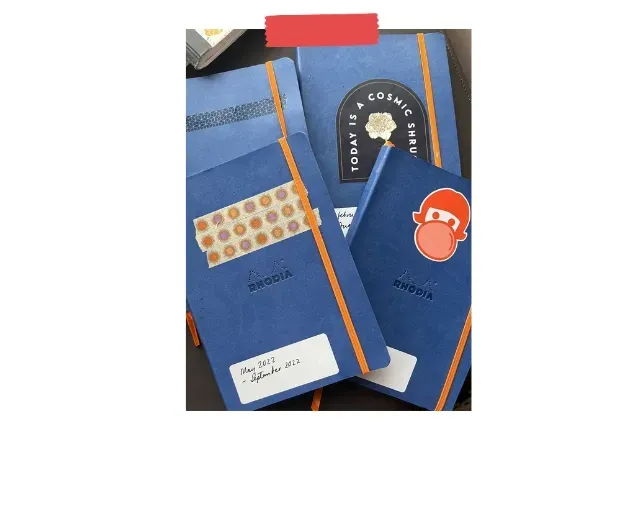
A paper I published back in 2010. I think it holds up.
Like the ancient Greeks who named the treacherous Black Sea “the Hospitable Sea,” we manage our anxieties by keeping Digital cute, small, and distant. We fill our electronic books with elaborately animated page curls and sepia inks not seen in a book store for centuries, while neglecting the readerly and writerly uses to which they will be put [6]. Our software is filled with skeuomorphic nostalgia for an imagined past, as the wire binding of our electronic notebook and the chads of discarded pages of our electronic calendar are lovingly reproduced on our screens. In place of its former enthusiasm for the promise of new forms, new media scholarship is increasingly concerned with archiving fragments of the recent past, that lost, golden age when we were sixteen.
By Niklaus Wirth (1995)
5. .... A system that is not understood in its entirety, or at least to a significant degree of detail by a single individual, should probably not be built.
This is interesting! I think “understood” is doing a lot of work here. Writing is complicated: did Shakespeare understand Hamlet? Wirth’s plea for lean software is an explanation for Oberon, his lean operating system. But A Midsummer Night’s Dream is a story of miscommunication and failure to follow instructions.
9. Programs should be written and polished until they acquire publication quality. It is infinitely more demanding to design a publishable program than one that “runs.” Programs should be written for human readers as well as computers. If this notion contradicts certain vested interests in the commercial world, it should at least find now resistance in academia.
To my eyes, the second sentence tends to contradict the first. I do agree that polishing — or at any rate tidying — programs is a good idea.
If you're thinking it might be good if President Biden stepped aside for someone younger and nicer to look at, what you really want is President Biden to be younger and nicer looking, and of course he wouldn't mind that either. But, as Keith Olbermann spells out so well in his latest Countdown, if he were to step aside that would basically concede the election to Trump. So if you think the old man is being silly and vain, well, he's being a lot smarter than you are, and btw, paying a huge price.
Why is there so little art depicting the moment we’re in? An essay by Rick Perlstein.
Why is there no great recent fiction about the American right? I have my theories. One is not unrelated to my suspicion that Section 501(c)(3) of the tax code may end up as the death of liberal democracy. Too much of liberal America doesn’t understand, or are bound within institutional confines that don’t allow them to understand, that conservatism is their adversary. Something that must be defeated if the most basic values that sustain a healthy society (whose flourishing too many liberals take for granted, or presume The Grown-Ups have under control) are to survive. For a way too big chunk of Blue America, the answer will always be more affirmations to “going high” when “they go low,” or that “there’s not a liberal America and a conservative America—there’s the United States of America.”
By Kent Beck, from 2016 but worth a look.
- Concentration. If you need to change several elements, first rearrange the code so the change only needs to happen in one element.
- Isolation. If you only need to change a part of an element, extract that part so the whole subelement changes.
I’ve been refactoring the .replace() operator in Tinderbox. This is straightforward for most attributes but fairly complex when replacing things in text. First, links have to be adjusted if the length of the replacement text differs from the length of the text it replaces. Second, we need to change the styled text as well as the unstyled text. So, there’s a bit of complexity lying about, made worse because Tinderbox shifted its regular expression engine a few years back, and the operator originally ran on the old engine.
See also: Kent Beck.
By Andy Matuschak and Michael Nielsen.
But retrospectively it’s difficult not to be disappointed, to feel that computers have not yet been nearly as transformative as far older tools for thought, such as language and writing.
This is the wrong standard to apply, one that not even Engelbart claimed. It shares with Engelbart’s mission a core problem: the singularity. If you did invent a widget that is as transformative as language, that widget would carry you to the far side of the singularity. Engelbart viewed that as a problem that the widget could solve, but of course the final solution of the post-human overlords might not be precisely what one would hope.
Instead of aiming for tools as transformative as language, how about tools as transformative as bookkeeping? Or library shelving?
Many people have spent years working on projects in this area. Some of those whose work doesn’t seem to be mentioned here include Ted Nelson, Doug Lenat, Norbert Streitz, Heiko Haller, Catherine C. Marshall, Claus Atzenbeck, Frank Shipman, Jamie Blustein, Ken Anderson, and me. (That’s just off the top of my head. Sorry for all the omissions.)
Matuschak and Nielsen assume that meaningful work in tools for thought occurs in big companies like Adobe. That’s not been my experience, though of course I’d say that.
Still, it’s 20,000 words and a lot of the ideas are important. Central: the importance of emotion to learning, and the crucial requirement that tools for thought be developed in tandem with deep, original creative work.
Tinderbox’s suggestion for a relevant link: As We May Think: New Notes.
By Patrick Dubroy.
I’m specifically interested in ways of making the power of programming available in a much more casual, informal way.... Since I’m interested in better tools to support casual programming, I wanted to have a bunch of concrete use cases. So, for the past couple of years, I’ve been jotting down a note whenever I find myself with a need for some casual programming.
I suppose Tinderbox actions are an example of casual programming
A superb introduction to the history of the notebook, from its medieval origins in Italy to its widespread modern use for art, literature, and learning, this volume invites comparison to Thomas Mallon’s wonderful study of diaries, A Book Of One’s Own. Allen is particularly strong on the close connection between notebooks and accounting, and the importance of accounting to the development of Europe: paper and ink turned out to be a superb defense against financial fraud because paper, unlike parchment, absorbs ink. Allen misses the laboratory notebook, unfortunately, but Jillian Hess covers that ground superbly in How Romantics and Victorians Organized Information. Though his dismissal of electronic tools is, I think, unjust, Allen’s volume is delightfully casual but taut and almost always insightful.

To honor the superb owl, I thought I’d make Italian beef sandwiches. Somehow, I’m also making special sandwich rolls for serving the Italian beef.
You know: it’s been years since I’ve written a true cheese sandwich post like this one. Maybe this really is a new weblog revival.
A New Yorker profile, by Larissa MacFarquhar, of the co-author of The Extended Mind, a 1998 philosophical essay which (among other things) is the respectable foundation for all the talk about “second brains”.
Mick Herron’s department of inept intelligence officers has one very bad day. A desk jockey bumps into an old boyfriend. He’s out of prison at last. Not much later, she realizes that she is being followed — and that her old boyfriend must have fingered her. Then things go seriously wrong. Herron can write.
Just grabbed an ancient copy of the Tinderbox document that generates this weblog in order to get the notes from 2001-2008 back into the main document. Mostly, everything seems to work. 7,114 notes and 1 million words used to overtax Tinderbox, but now things seem to be fine.
When I pruned the document in 2011, John Gruber was writing about the iPhone 4. President Obama was winding up the war in Iraq. The King’s Speech had won Best Picture. The Sense of an Ending won the Booker, Connie Willis’s Blackout/All Clear won the Hugo, and the Packers beat the Steelers in the Super Bowl.
…so then I'll launch my Blog.tbx file and remember how damn good Tinderbox is at everything.
And I enjoy using Tinderbox. It's not for everyone, to be sure. But it rewards patience and commitment. It's a unique and powerful tool, and it's been around for a long time.
There’s been some discussion of using Tinderbox for historical research on the Tinderbox Forum lately. Unfortunately, that’s drifted into hand-wringing over details — documentation bugs remembered from 2017, complaints that the [Return] key as a shortcut doesn’t work in Tinderbox exactly as it works in some other system.
I’m going to write a bit about how I might use Tinderbox to write some history. I’m not a historian: take that into account. I’m not going to actually do the historical research here (though I’m really tempted). I’m going to try not to make things up (hi, GPT!) but I’m going to wing things from memory: if for some reason you use anything here, check it. The examples will be real Tinderbox, but they’re toy examples at tiny scale. Fill in the rest.
I’m interested in looking at Ostia in the 3rd and 4th century as a tourist town.
This isn’t a good research question. That comes later. I want to think about later Roman Ostia — the Ostia we know — through the lens of contemporary Wellfleet MA.
Ostia was the port of Ancient Rome. The Romans thought it had been founded as a military fort in the age of kings; there was a big sign commemorating the foundation by Ancus Martius, who was about as distant from our period as we are from Chaucer and Genghis Khan. Here it is:
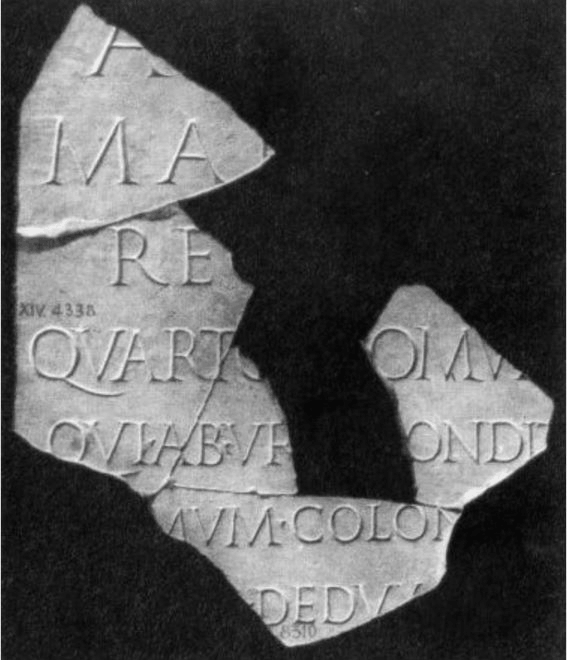
In the early Empire, Ostia had been one of the busiest ports of the world. Claudius rebuilt the harbor, but it was never entirely satisfactory and Trajan built a new and better harbor at Portus, just a bit up the coast. Ostia retained quite a few fancy houses, apartment buildings, and such for centuries after the business went to the new port. Eventually, the old harbor silted up completely, the Tiber shifted its course, and the whole place became a malarial swamp. As a result, it's remarkably preserved.
Wellfleet means “whale fleet”. A town on Cape Cod, it was an important harbor in the colonial era. The whaling industry was wrecked by the Revolutionary War, but fishing kept the town busy and prosperous through much of the 19th century. The long, slow decline of New England fishing gradually led the town to become a village of summer homes with a smattering of artists and artisans. Linda and I often spend a long weekend with friends. There are galleries and boutiques, good birding, plenty of fried fish and lobster and some more serious food. It’s fun.
Is it useful to think of 3rd century Ostia as something like Wellfleet?
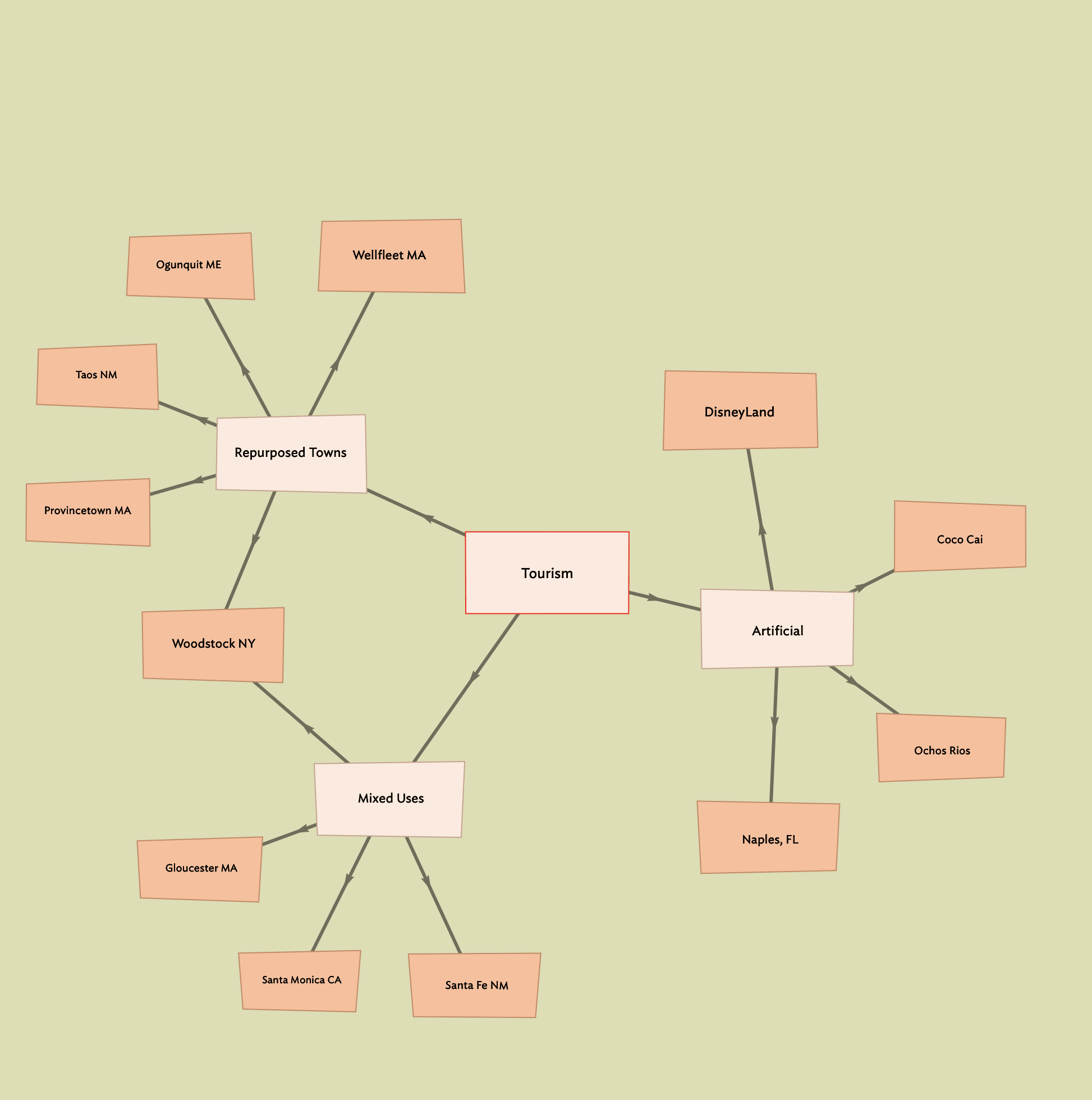
At the outset, decent research topics do tend to be fuzzy. That’s why premature formalization is bad, and it’s why we need Tinderbox.
That phrase, “like Wellfleet”, is frightfully vague. What does it mean? I don’t know! I suppose I’m wondering whether we should think all those little streetfront shops sold nails and farm supplies, or whether we should imagine them filled with souvenirs and knick-knacks. Do we think of those tabernae as dive bars, or trendy places to sample farmstead wine with a dish of tripe façon grand-mère. How might we know?
To pin down what “like Wellfleet” might mean, I started by dividing tourist destinations into three parts. Some destinations are entirely invented, like Disneyland. Some destinations are perfectly normal workaday places where people like to go — Santa Monica, say, or Santa Fe. You might live in Santa Monica because you work there, but people spend a lot of money to live there because it’s a nice place to live. If you go to a party in Woodstock NY, you might meet a third-generation goat farmer or you might meet a retired rock star.
Then, there are towns like Wellfleet that had a purpose, lost it, and tried something else.
This sort of brainstorming can be terrifically valuable at every stage of research. The Tinderbox map view is great for this. Here, though, I reached for the hyperbolic view, which views links:
So, if 3rd century Ostia was a repurposed town, what might we expect to see?
One of the attractions of repurposed villages is that you can find fine old, old-fashioned houses. In cities, these places get cleared out because they sit on valuable land, but the land in the repurposed villages isn’t valuable anymore.
Ostia does have quite a few late houses of the traditional domus variety, some of which go back centuries. I don’t think it’s unreasonable to suppose an element of nostalgia — even nostalgia for an imagined past, or for someone else’s past. Your own ancestors may have been painting themselves in woad when the house was built, sure, but now you’re living like a Scipio.
It’s fun to live in an antique house, but that’s not for everybody. Some people want the latest comforts, and they want to be see to have those comforts. I think one place to look for those houses is along the (former) seacoast southwest of town. Another place to look is for conversions of old industrial or civic structures to residences — something hardly unknown in Ostia.
Tinderbox notes can handle quantitative and well as quantitative notes. Want to do a study of the number of domus buildings per block across the city? Want to study the ratio between shops and stairways? Add some attributes and away you go.
Don’t forget the attribute browser. If you make a note for each prominent building and have attributes for (say) surviving stairways, you can easily locate buildings with lots of stairs and examine their other properties.
That big inscription for King Ancus we saw above is a sort of historic marker, but it’s also a convention of Roman iconography. Intriguingly, there’s another set of historical markers hiding in plain sight: signs scattered across the city that relate to Saint Monica — Santa Monica! — the mother of Augustine. She died in Ostia in 387 with Augustine at her side as they were waiting for a ship back to North Africa, and after her death it seems that someone made a point of marking out the real places you could get close to the Saint.
I recalled this because I read Boin’s Ostia In Late Antiquity a year or two back, and it made this interesting point. You don’t do this for locals: the people of Rome knew where Paul had been chained up and what the Colosseum was for. You put up historical markers for the transients, the summer people. George Washington stopped here: come inside for a cold beer!
I’ve never cited anything about Ostia in my computer science research, so none of it is in my Bookends Library. No worries: I opened Bookends and had it check the Library Of Congress index records for Boin’s book, and also Russell Meiggs wonderful Roman Ostia. I had Meiggs on Ostia at Swarthmore, and that semester casts a long shadow. ⌘⌥-drag the references into Tinderbox, and we’ve got reference notes all set to go.
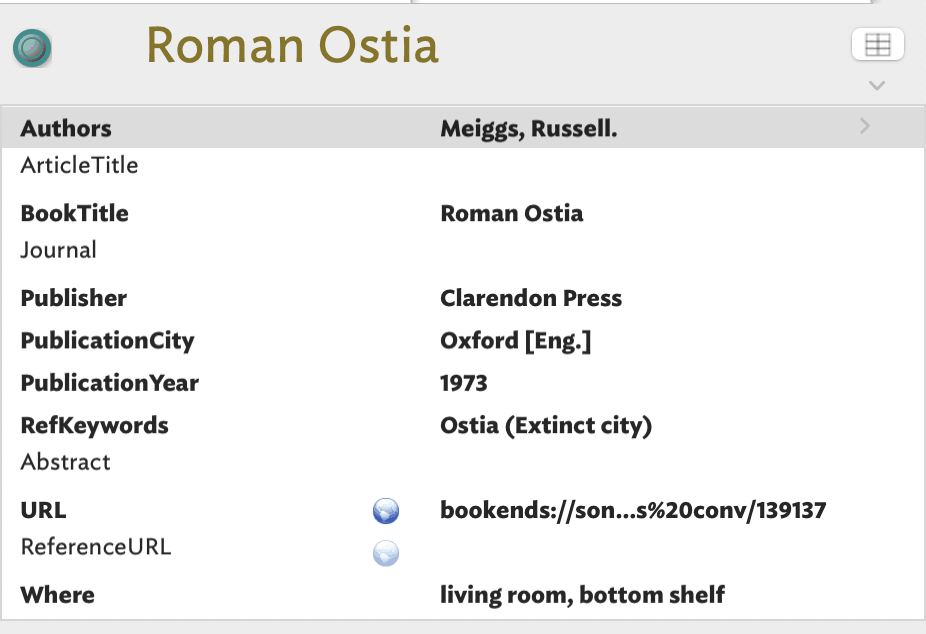
I added a new attribute, Where, because I’m in a hurry. Where is the book? I think it’s at home, in the living room. I am not going to look stuff up, lest I spend a week up to my elbows in Romans. But, if I need it, I think I know where it is.
This is an important aspect of Tinderbox. We don’t need to get the information architecture right from the outset. We can add the metadata we expect we will want. If you change your mind later, you can add more, or drop what didn’t prove useful.
Repurposed towns need cultural amenities. The cost of redevelopment must be borne by people from more prosperous places, people who want to vacation in quaintness or retire to serenity. If the locals could afford it, we wouldn’t be redeveloping. But quaintness pales if you have to run up to town whenever you want a little fun or a bit of culture.
Ostia has a big and well-preserved theater, a possible art museum, a ton of public statuary, and a good deal of public parks and gardens. Wellfleet has two theater companies, a music venue just over the town line, and a bunch of galleries.
It might be interesting to take a look at surviving mosaics to see how they are distributed across the city, and how many are more or less public. That’s another nice use for map view. Maps of geographic maps aren’t a very profound use of spatial hypertext, but they make a nice kind of informal sketch that is exceptionally open to annotation and correction.
In writing about museums and theaters, I recalled reading a paper that speculated that a particular late house, rather elite, might have housed a collection of old statues relocated from other parts of the city. I don’t remember the paper: I read history for fun and I don’t take systematic notes. But I thought it might be Mary Jane Cuyler, “Legend and Archaeology at Ostia: P. Lucilius Gamala and the Quattro Tempietti”, BABESCH 94 (2019), 127-146.
It wasn’t.
But good old Publius Lucilius Gamala is an old friend of mine, and this is a dandy paper. We start with a conference presentation from 1907 — Cuyler has one of the slides! — that presented one wrong theory about the “Four Temples” next to the theater. A big inscription called CIL XIV 375 once commemorated Mr. Gamala and lists his many good deeds, which include building four temples. There’s another, CIL XIV 376, that commemorates Mr. Gamala for restoring four temples. It’s easy to assume they’re the same guy, but 376 is probably a monument to a descendant of 375 who restored the temples that great-grandad built. (Even 375 had a father and grandfather with the same name: Romans did that, and so 376 might be P. Lucilius Gamala VIII for all we know.).
My teacher Meiggs walked us through these two inscriptions as a class exercise, in part because he’d solved the dating of 375 and established that 376 was a descendant emulating his ancestor. Cuyler has that solution — and a bunch of solutions proposed since then! She also has a comprehensive list of prior solutions and their arguments. (The original Lucilius Gamala may well have started out in Galilee where there was a town named Gamala, now Gamla.) Getting the dates right also involves knotty problems involving references to fundraising for naval wars, public feasts, the period of time in which various abbreviations were fashionable, and more. We still have 376 but someone misplaced 375 a few centuries back.
This is a ton of fun. But we’re on deadline.
This is one of the core strengths of Tinderbox for historical research: links persist even though we may rename, move, and reinterpret notes, and links don’t require a fixed anchor. So, when Cuyler tells us to read D’Arms and Zevi, and cites the elogia of Arezzo (what’s that?) in connection with Silvio Panciera, we can note and link the references and chase them down later.
That day might not be today, but the links will be there when we need them.
The Peutinger Table is a medieval copy of a Roman travel guide, showing facilities for official government travel. It shows Ostia as a “two-roof” stop which is pretty substantial: Naples and Brindisi have the same amenities.

We don’t know exactly what facilities a “two-roof” town offered, but surely the point is that you’d know whether the town ahead was a place to stay, or you needed to push ahead to the next town with a decent hotel with a business center and a gym. Certainly, hotels and lodging houses are essential to repurposed towns.
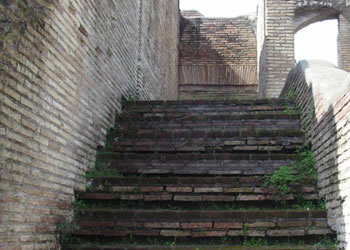
Here’s a stairway going up to the nice apartments on the first floor of a multistory Ostia apartment building. Might it have been a hotel at some point? You know what? When it comes to hotels in the Roman Empire, I’m pretty much drawing a blank. Nothing in the Oxford Classical Dictionary, either.
Very wealthy people, of course, would stay with friends or with “friends” wherever they went. Cicero, certainly, arranges to borrow people’s houses when they’re away. This might have been fairly widespread, and at a slightly more modest stratum money might have changed hands. This reminds me of the advertisement that precipitates Elizabeth von Arnim’s Enchanted April:
To Those Who Appreciate Wisteria and Sunshine. Small mediaeval Italian Castle on the shores of the Mediterranean to be Let furnished for the month of April. Necessary servants remain. Z, Box 1000. The Times.
Might those seaside villas have been let to visitors, along with necessary servants? I wonder, too, about Ostia’s many large apartment buildings, a number of which still stand to the height of several stories. In the first and second centuries, these would have been necessary for housing dockworkers, stevedores and longshoremen. Might some have served as Grand Hotels a century or two down the line? I’ve certainly paid handsomely to stay in remodeled servants’ rooms in repurposed fancy homes. What archaeological trace might point in that direction?
Links aren’t just for citation. Whenever historical research is going well, it throws off numerous questions to be pursued later. When it is not going well, it throws off even more questions. Speculations ought to be noted, and they ought to be marked as speculative. We turn from defining a technical term in German philology to noting some task that needs to be done.
Tinderbox’s suite of tools — agents to gather and organize, prototypes to classify, actions to enforce constraints — is the best way I know to handle this sort of radically heterogeneous information.
The food world of Ostia often seems strikingly familiar. Taverns (tabernae) had bars and bartenders, and behind the bar you’d see three shelves of deliciously intoxicating drinks. There were food shops with maritime mosaics built into their floors. Surely, these are the antecedents of Wellfleet’s Wicked Oyster?

A new feature of Tinderbox is table view. You can view a bunch of notes as a table, which is handy if you’ve got a bunch of notes describing bars and eateries. Have a hankering to put that data in a spreadsheet? Just copy and paste. You can go in the opposite direction too, naturally.
There are a lot of religious buildings in Ostia. OK: it was occupied for six or seven centuries, and religious structures tend to be conserved. Still, it’s a lot.
And that’s not counting the array of elaborate tombs lining the nearby roads. Romans viewed graveyards differently: they liked, for example, to have dinner parties in ancestral tombs, so grandpa could drop in.
But I think we ought to view those churches alongside all the “guilds” and civic orders and clubs, all of which are especially well attested in Ostia. There’s a synagogue just outside the seaward gate, which was enlarged and improved in the second century. There had been an earlier building on the site, but since there were pig bones in the debris, it probably wasn’t a synagogue. (You never know about pogroms, though Occam’s razor is at present an obstacle). All this clubbiness likely made it nicer for people relocating from the city, offering chunks of community into which the newcomer could find (or purchase) entrance.
We know lots of names from Ostia, not least because lots of the clubs had big plaques honoring their members. Nineteenth century epigraphers were great at indexing and cross-referencing these names, and perhaps this has all been covered satisfactorily.
But you might not be working in Ostia, and there are lots of areas that haven’t had nearly this level of scrutiny.
Do you think Mommsen and Dessau might have liked to have Tinderbox’s search tools? Take another look at that Ancus Martius inscription photographed above: you can get a lot of mileage from a piece of an A on one line and and “MA” on the next!
This sort of sifting is even more important in modern history, because there is more evidence than you can encompass.
Last year, Robbie George briefly made Roman brothels the center of abortion controversy. It’s not clear that we know of any brothels in Ostia. There’s a candidate, but it may be better to view it as first-century mansion that, by the third century had become a fancy hotel.
Eventually, this research ought to become a piece of writing.
How is it to be organized? Where will we start? Again, I think Tinderbox offers some very nice affordances that you don’t often see.
For example, we might begin with a view of Main St. Wellfleet, and move from there to repurposed towns and thence to specific ruins in Ostia.
Or, we might start with one specific building in Wellfleet: perhaps a fancy restaurant that used to be a very unfancy bar, and that before that was a private house that replaced a cottage where a colonial whaling captain had lived. That might give us a hook to the possible hotel.
With Tinderbox, we can experiment with many different organizations. We can look at transitions, change perspective and point of view. We can reverse the narrative and see if that works. The concreteness of Tinderbox notes lends itself to narrative experimentation.
OK: times up, pencils down. That shot a perfectly good day.
All this is probably too elaborate. Still, it’s nice to know it’s there.
I haven’t talked much about actions — about the way notes can act on other notes to keep things organized. That’s really important for long-term projects.
I haven’t said anything about export. It’s pretty trivial nowadays. Select what you want to export, select the text, copy. Or export everything to plain text, RTF, Word, OPML, whatever. Your data is yours.
Questions? Email me.
Corrections? Let me know!
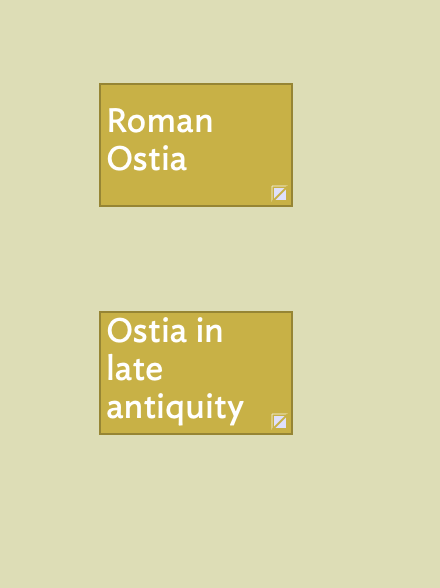
(This page, like the rest of the site, was written in Tinderbox)
You can make fresh pasta. You don’t need a pasta machine, electric or hand-cranked. You don’t need much time: Ruhlman says it shouldn’t take more than 20 minutes, which sounds about right. Here’s last Sunday’s dinner: strozzapreti (“priest stranglers”) with beans.
Now that the U.S. is on course to betray Ukraine and side with Russia, thanks to Trump’s party, Phillips O’Brian has a list of ten urgent steps Europe must take for its own defense.
European states must therefore start operating on the assumption that Trump will win—and in that case they will be left on their own to look after their security. It will require a very different mindset than has existed since 1945, and a willingness to be decisive in a way that does not come natural to European states.
“People are saying things about Jews that they were saying in the 1300s.”
— Times Radio (@TimesRadio) February 3, 2024
Author Howard Jacobson says he “can’t sleep at night” and he is “flabbergasted” by the state of antisemitism in Britain.@HugoRifkind | #TimesRadio pic.twitter.com/EOZ6A2t3at
Technology Review had a piece on Digital Gardens by Tanya Basu that I missed back in 2020.
Mending, The Northern Star Symposium 2024 at Nord Universitet, Bødo. Hello, Torill Motensten, Førsteamaneunsis!
A timely title, though possibly premature; perhaps we ought to ensure that there will be a future beyond 2024 before we get down to patching things up. On the other hand, this is why we have universities: to plan out happy/happier outcomes just when things look darkest.
I’m tempted to write something about repairing our enshittified, villainous Web, though Bødo is an expensive ticket.
In any case, it’s a really well-written call for papers.
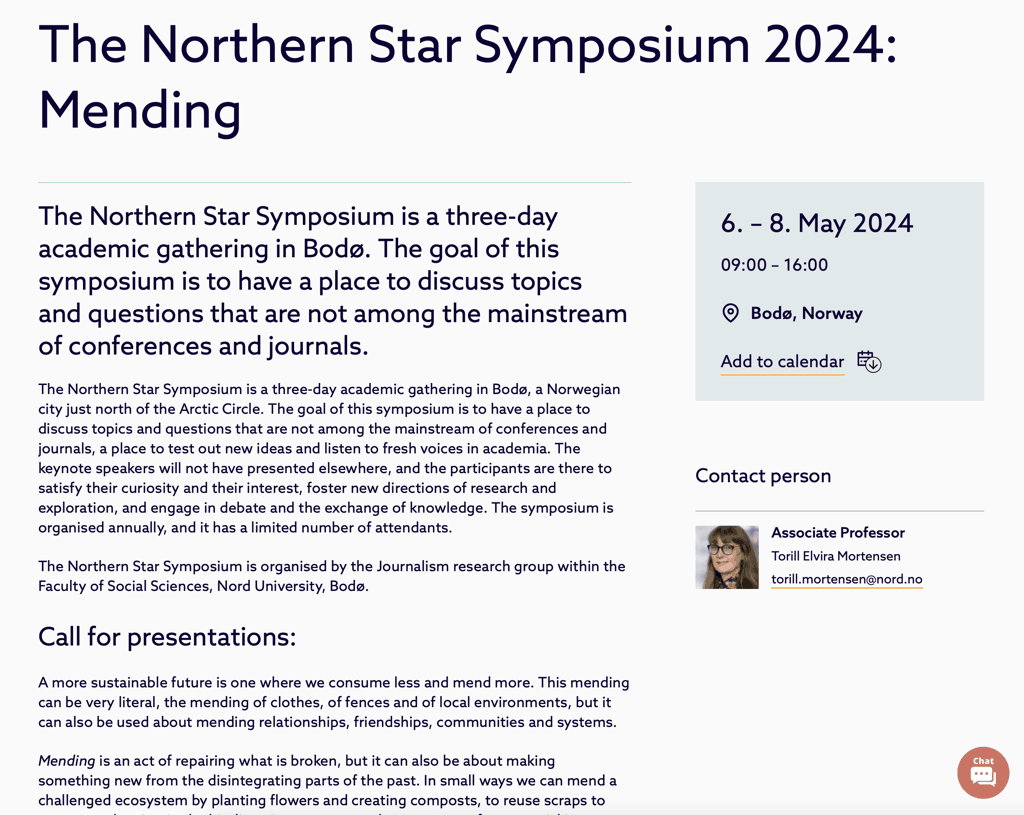
Kent Beck, one of the originators of Agile Computing, has a new newsletter and a new book, Tidy First?. The book is terrific — a polished, political exploration of how to take better care of your code by taking better care of yourself. More on that soon.
A terrific thriller, even better than Slow Horses. Slough House is the place where MI-5 sends fuckups who, for one reason or another, cannot simply be dismissed. They do dull clerical tasks, searching for intelligence in places where no intelligence is to be found. Still, it’s a job, and therefore better than being kicked out entirely. One of the guys who did get kicked to the curb, one day, comes out of a pub and sees a Russian hood he used to know in Berlin, walking down the street. He starts a one-man tail job, which turns out just as badly as you might expect. Very fine, indeed.
Emily Wilde is a young Cambridge don who studies dryadology — the ethnography of faeries. In fact, she’s the youngest fellow in history of her department. She’s off for a short trip to Iceland, or someplace quite like it, to discover some facts about the Silent Folk. She learns a lot.
This is a pleasant and a charming book. It doesn’t startle or soar: that would be unmannerly, maybe uncanny. Fawcett has an interesting knack of forgivable cheating — as do many of her faeries: Wilde is often saved by dei ex machina, which is then excused because everyone knows something about faeries that Fawcett has not actually established here. Once you get the hang of it, it hangs together: of course faeries can do that, because you know stories where faeries do it. Of course faeries love something and hate something else, because you’ve stories about that, too. Everything you have heard is mostly right, which (when you think about it) makes even the little folk terrific.
Andrew Janjigian is an organic chemist who has switched to pizza baking. “Janjigian easily transitioned from cooking to chemistry, citing similarities between the two. ‘Taking ingredients — cooking and mixing them, heating them, transforming them into things,.”
(Ghastly page design in WickedLocal; read this in Reader View or, at least, with ad blocker active. I’m old enough to remember when people worked to make web pages better, not shittier.‚